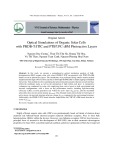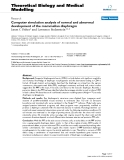
A NOVEL CONTROL STRATEGY TO ENHANCE THE DYNAMIC
RESPONSE OF THE WIND ENERGY CONVERSION SYSTEM
USING A DOUBLY FED INDUCTION GENERATOR BASED ON AN
INTELLIGENT FUZZY-PI CONTROLLER
Nguyen Thi Hue
1
, Huynh Hoang Bao Nghia
2
, Le Van Dai
2*
1
Dong Nai Technology University
2
Industrial University of Ho Chi Minh City
*Corresponding author: Le Van Dai, levandai@iuh.edu.vn
1. INTRODUCTION
The increasing global demand for electrical
energy has intensified its influence on
geopolitical issues, including economic and
environmental concerns. Renewable energy
sources such as wind, solar, and hydroelectric
power are becoming critical solutions to meet
current and future electricity demands
worldwide (Le Dai, Pham, 2023). Among
these, wind energy contributes approximately
24% to the global renewable energy mix as of
2023, making it one of the most promising
sources of electricity generation (LV Dai,
Tung, 2017; Hassan et al., 2024). Wind turbines
(WTs), as a crucial component of wind energy
conversion systems, are responsible for
converting kinetic energy from wind into
electrical energy, with modern turbine
efficiencies reaching up to 50%. Over the years,
advancements in wind turbine technologies
have led to the development of three primary
operational types: fixed-speed, semi-variable
speed, and variable-speed turbines, with
variable-speed systems achieving up to 30%
GENERAL INFORMATION ABSTRACT
Received date: 10/11/2024 This paper introduces a practical and simple power control
method for wind energy conversion systems based on a
doubly-fed induction generator. Due to the limitations of
traditional proportional-integral controllers when the
parameters of the doubly-fed induction generator and wind
speed vary, fuzzy control theory is applied to overcome these
challenges. First, a detailed mathematical model of the
induction generator in the dq domain is provided. Then, based
on the characteristics of the doubly-fed induction generator, an
enhanced mathematical model is presented along with a vector
control model for the generator. Subsequently, the
mathematical model for the wind turbine and the fuzzy
controller based on the proportional-integral controller are
developed and implemented in MATLAB/Simulink for
simulation and performance evaluation. Simulation results
indicate that the proposed method for controlling the doubly-
fed induction generator can significantly improve the dynamic
response performance under varying generator parameters and
wind speed conditions.
Revised date: 03/01/2025
Accepted date: 08/01/2025
KEYWORD
Doubly fed induction generator
(DFIG);
Dynamic response;
Fuzzy control;
Wind energy conversion system
(WECS);
Proportional-integral (PI);
Simulation analysis
.
01-2025
10












